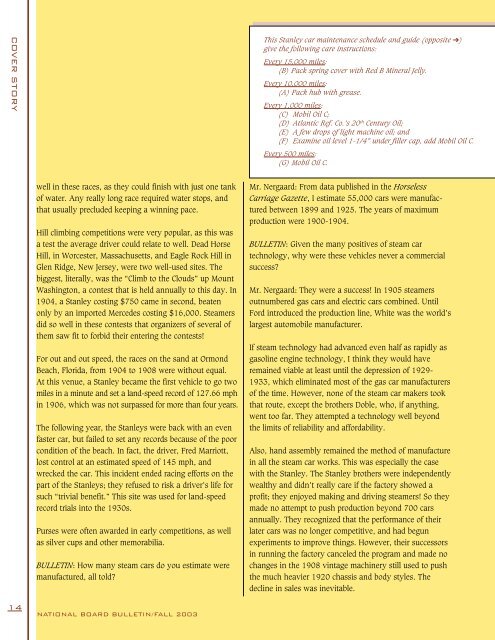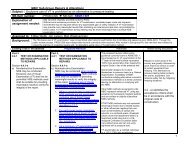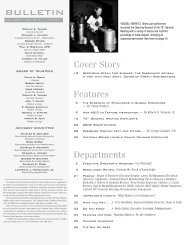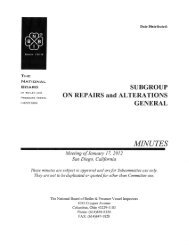bulletin - The National Board of Boiler and Pressure Vessel Inspectors
bulletin - The National Board of Boiler and Pressure Vessel Inspectors
bulletin - The National Board of Boiler and Pressure Vessel Inspectors
You also want an ePaper? Increase the reach of your titles
YUMPU automatically turns print PDFs into web optimized ePapers that Google loves.
COVER STORY<br />
14<br />
well in these races, as they could finish with just one tank<br />
<strong>of</strong> water. Any really long race required water stops, <strong>and</strong><br />
that usually precluded keeping a winning pace.<br />
Hill climbing competitions were very popular, as this was<br />
a test the average driver could relate to well. Dead Horse<br />
Hill, in Worcester, Massachusetts, <strong>and</strong> Eagle Rock Hill in<br />
Glen Ridge, New Jersey, were two well-used sites. <strong>The</strong><br />
biggest, literally, was the “Climb to the Clouds” up Mount<br />
Washington, a contest that is held annually to this day. In<br />
1904, a Stanley costing $750 came in second, beaten<br />
only by an imported Mercedes costing $16,000. Steamers<br />
did so well in these contests that organizers <strong>of</strong> several <strong>of</strong><br />
them saw fit to forbid their entering the contests!<br />
For out <strong>and</strong> out speed, the races on the s<strong>and</strong> at Ormond<br />
Beach, Florida, from 1904 to 1908 were without equal.<br />
At this venue, a Stanley became the first vehicle to go two<br />
miles in a minute <strong>and</strong> set a l<strong>and</strong>-speed record <strong>of</strong> 127.66 mph<br />
in 1906, which was not surpassed for more than four years.<br />
<strong>The</strong> following year, the Stanleys were back with an even<br />
faster car, but failed to set any records because <strong>of</strong> the poor<br />
condition <strong>of</strong> the beach. In fact, the driver, Fred Marriott,<br />
lost control at an estimated speed <strong>of</strong> 145 mph, <strong>and</strong><br />
wrecked the car. This incident ended racing efforts on the<br />
part <strong>of</strong> the Stanleys; they refused to risk a driver’s life for<br />
such “trivial benefit.” This site was used for l<strong>and</strong>-speed<br />
record trials into the 1930s.<br />
Purses were <strong>of</strong>ten awarded in early competitions, as well<br />
as silver cups <strong>and</strong> other memorabilia.<br />
BULLETIN: How many steam cars do you estimate were<br />
manufactured, all told?<br />
NATIONAL BOARD BULLETIN/FALL 2003<br />
This Stanley car maintenance schedule <strong>and</strong> guide (opposite ➔)<br />
give the following care instructions:<br />
Every 15,000 miles:<br />
(B) Pack spring cover with Red B Mineral Jelly.<br />
Every 10,000 miles:<br />
(A) Pack hub with grease.<br />
Every 1,000 miles:<br />
(C) Mobil Oil C;<br />
(D) Atlantic Ref. Co.’s 20 th Century Oil;<br />
(E) A few drops <strong>of</strong> light machine oil; <strong>and</strong><br />
(F) Examine oil level 1-1/4” under filler cap, add Mobil Oil C.<br />
Every 500 miles:<br />
(G) Mobil Oil C.<br />
Mr. Nergaard: From data published in the Horseless<br />
Carriage Gazette, I estimate 55,000 cars were manufactured<br />
between 1899 <strong>and</strong> 1925. <strong>The</strong> years <strong>of</strong> maximum<br />
production were 1900-1904.<br />
BULLETIN: Given the many positives <strong>of</strong> steam car<br />
technology, why were these vehicles never a commercial<br />
success?<br />
Mr. Nergaard: <strong>The</strong>y were a success! In 1905 steamers<br />
outnumbered gas cars <strong>and</strong> electric cars combined. Until<br />
Ford introduced the production line, White was the world’s<br />
largest automobile manufacturer.<br />
If steam technology had advanced even half as rapidly as<br />
gasoline engine technology, I think they would have<br />
remained viable at least until the depression <strong>of</strong> 1929-<br />
1933, which eliminated most <strong>of</strong> the gas car manufacturers<br />
<strong>of</strong> the time. However, none <strong>of</strong> the steam car makers took<br />
that route, except the brothers Doble, who, if anything,<br />
went too far. <strong>The</strong>y attempted a technology well beyond<br />
the limits <strong>of</strong> reliability <strong>and</strong> affordability.<br />
Also, h<strong>and</strong> assembly remained the method <strong>of</strong> manufacture<br />
in all the steam car works. This was especially the case<br />
with the Stanley. <strong>The</strong> Stanley brothers were independently<br />
wealthy <strong>and</strong> didn’t really care if the factory showed a<br />
pr<strong>of</strong>it; they enjoyed making <strong>and</strong> driving steamers! So they<br />
made no attempt to push production beyond 700 cars<br />
annually. <strong>The</strong>y recognized that the performance <strong>of</strong> their<br />
later cars was no longer competitive, <strong>and</strong> had begun<br />
experiments to improve things. However, their successors<br />
in running the factory canceled the program <strong>and</strong> made no<br />
changes in the 1908 vintage machinery still used to push<br />
the much heavier 1920 chassis <strong>and</strong> body styles. <strong>The</strong><br />
decline in sales was inevitable.








